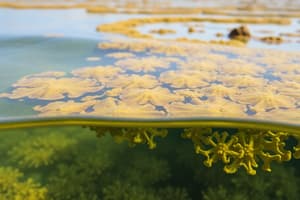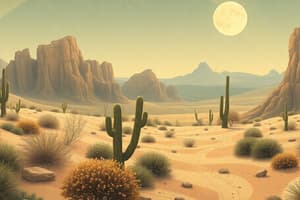Podcast
Questions and Answers
What distinguishes tropical savanna from dry forests?
What distinguishes tropical savanna from dry forests?
- Dry forests experience more frequent fires than savannas.
- Savannas have grasses, while dry forests do not. (correct)
- Dry forests have a longer dry season than savannas.
- Savannas have a higher water availability than dry forests.
Which of the following is NOT a characteristic of Mediterranean shrubland?
Which of the following is NOT a characteristic of Mediterranean shrubland?
- Characterized by winter rainfall and hot, dry summers.
- Dominated by deciduous trees, shedding leaves seasonally. (correct)
- Located at approximately 30-35 degrees latitude.
- Dominated by evergreen shrubs with small, hard leaves.
What is the primary factor limiting the distribution of producers in aquatic ecosystems?
What is the primary factor limiting the distribution of producers in aquatic ecosystems?
- Climate
- Availability of nutrients
- Presence of predators
- Depth (correct)
Which of the following is NOT a process involved in the hydrologic cycle?
Which of the following is NOT a process involved in the hydrologic cycle?
Which of the following is a defining characteristic of a temperate grassland?
Which of the following is a defining characteristic of a temperate grassland?
What is the primary difference between northern coniferous forests and boreal forests?
What is the primary difference between northern coniferous forests and boreal forests?
Where are polar deserts typically found?
Where are polar deserts typically found?
Which of the following is NOT a characteristic of a desert ecosystem?
Which of the following is NOT a characteristic of a desert ecosystem?
Which of the following is a characteristic of both tropical rainforests and tropical dry forests?
Which of the following is a characteristic of both tropical rainforests and tropical dry forests?
What is the major distinction between temperate grasslands and temperate forests?
What is the major distinction between temperate grasslands and temperate forests?
What is the predominant type of vegetation found in the photic zone of an aquatic ecosystem?
What is the predominant type of vegetation found in the photic zone of an aquatic ecosystem?
What is the primary source of energy for the hydrologic cycle?
What is the primary source of energy for the hydrologic cycle?
What is the primary reason why trees cannot grow in the tundra?
What is the primary reason why trees cannot grow in the tundra?
What is the primary reason why coastal rainforests in BC receive significantly more precipitation than interior grasslands?
What is the primary reason why coastal rainforests in BC receive significantly more precipitation than interior grasslands?
What is the most abundant type of water on Earth?
What is the most abundant type of water on Earth?
Which of the following is NOT a characteristic of aquatic biomes?
Which of the following is NOT a characteristic of aquatic biomes?
What is the maximum depth of the photic zone?
What is the maximum depth of the photic zone?
What is the name of the area where the continental shelf drops off very rapidly?
What is the name of the area where the continental shelf drops off very rapidly?
Why are minerals and nutrients low in the center of the ocean?
Why are minerals and nutrients low in the center of the ocean?
What is the primary reason that kelp forests are found in cold, temperate water?
What is the primary reason that kelp forests are found in cold, temperate water?
What is the primary characteristic that distinguishes the coastal zone from the oceanic zone?
What is the primary characteristic that distinguishes the coastal zone from the oceanic zone?
What is the main factor that determines the type of biome present in a particular location?
What is the main factor that determines the type of biome present in a particular location?
What are the three main structural forms of land plants?
What are the three main structural forms of land plants?
Which of the following is NOT a factor that can influence the development of an ecosystem within a specific climate zone?
Which of the following is NOT a factor that can influence the development of an ecosystem within a specific climate zone?
Which of these ecosystems is defined by its cold temperatures and lack of trees?
Which of these ecosystems is defined by its cold temperatures and lack of trees?
What is the relationship between the first trophic level and the biome's structure?
What is the relationship between the first trophic level and the biome's structure?
What does the acronym MAP refer to in the context of climate parameters?
What does the acronym MAP refer to in the context of climate parameters?
What is the key difference between a temperate forest and a tropical rainforest?
What is the key difference between a temperate forest and a tropical rainforest?
How does the concept of convergent evolution apply to biomes?
How does the concept of convergent evolution apply to biomes?
Flashcards
Biomes
Biomes
Different types of ecosystems identified by climate and dominant producers.
Trophic level
Trophic level
A level in an ecosystem defined by how energy and nutrients are passed through.
Dominant producers
Dominant producers
The main species that produce energy in an ecosystem, like plants.
Terrestrial biomes
Terrestrial biomes
Signup and view all the flashcards
Forest description
Forest description
Signup and view all the flashcards
Herb definition
Herb definition
Signup and view all the flashcards
Mean Annual Precipitation (MAP)
Mean Annual Precipitation (MAP)
Signup and view all the flashcards
Role of fire in ecosystems
Role of fire in ecosystems
Signup and view all the flashcards
Tropical Forests
Tropical Forests
Signup and view all the flashcards
Rain Forest
Rain Forest
Signup and view all the flashcards
Dry Forest
Dry Forest
Signup and view all the flashcards
Tropical Savanna
Tropical Savanna
Signup and view all the flashcards
Deserts
Deserts
Signup and view all the flashcards
Mediterranean Shrubland
Mediterranean Shrubland
Signup and view all the flashcards
Temperate Grassland
Temperate Grassland
Signup and view all the flashcards
Temperate Forests
Temperate Forests
Signup and view all the flashcards
Boreal Forests
Boreal Forests
Signup and view all the flashcards
Tundra
Tundra
Signup and view all the flashcards
Hydrologic Cycle
Hydrologic Cycle
Signup and view all the flashcards
Photic Zone
Photic Zone
Signup and view all the flashcards
Aquatic Biomes
Aquatic Biomes
Signup and view all the flashcards
Algae
Algae
Signup and view all the flashcards
Endemic Species
Endemic Species
Signup and view all the flashcards
Twilight zone
Twilight zone
Signup and view all the flashcards
Continental shelf
Continental shelf
Signup and view all the flashcards
Kelp forests
Kelp forests
Signup and view all the flashcards
Coral reefs
Coral reefs
Signup and view all the flashcards
Study Notes
Biomes and Ecosystems
- Biomes are distinct ecosystems defined by climate and dominant producers.
- Biome structure is primarily determined by the producers (first trophic level).
- Convergent structures (similar, but different species) exist across continents in comparable biomes.
- Key factors influencing biome distribution and structure include: climate (major influence), fire, soil, herbivores, and producers.
- Terrestrial biomes may span globally, exhibiting similar climate characteristics (latitude, precipitation, temperature) while having different species.
Terrestrial Biome Types
- Forests: Ecosystems dominated by trees (10+ meters tall).
- Shrubs: Woody plants with multiple stems, smaller than trees.
- Herbs: Non-woody plants (e.g., grasses).
- Forests develop in areas with adequate precipitation and moisture.
Climate Parameters
- Climate is described using Mean Annual Precipitation (MAP) and Mean Annual Temperature (MAT).
- Different climate zones (e.g., tundra, boreal forest, temperate forest, tropical rainforest, etc.) are associated with specific biomes based on temperature-precipitation relationships.
Tropical Forests
- Rainforests: Characterized by little seasonal variation, tall trees, broad-leaved evergreen trees, high rainfall, and equatorial location.
- Dry forests: Experience longer dry seasons, deciduous trees (shed leaves during dry periods), and have substantial shrubbery and other plants.
Tropical Savanna
- Savannahs are grasslands with scattered trees.
- Savannas are differentiated from dry forests by their dominant grasses.
- Frequent fires are common in savannas.
Deserts
- Deserts are dry ecosystems often formed by descending air masses with high pressure.
- They are too dry for substantial tree growth.
- Deserts exhibit a wide temperature range - both hot and cold deserts exist.
- Deserts are dominated by shrubs, succulents (e.g., Joshua trees), or sparse grasses.
Mediterranean Shrubland
- Found at approximately 30-35 degrees latitude in various locations (Southern Africa, Southern Australia, parts of Chile, California, Mediterranean).
- Characterized by winter rainfall and hot, dry summers.
- Dominated by evergreen shrubs with small, hard, flammable leaves.
- Often harbors many endemic (unique to an area) species.
Temperate Grassland
- Located in areas approaching 60 degrees latitude.
- Dry continental climate, frequent fires, and lack of significant moisture are typical traits.
- Seasonal precipitation patterns are observed.
Temperate Forests
- Located in coastal areas at the same latitudes as temperate grasslands.
- Comprises broad-leaved forests (deciduous or evergreen, including eucalyptus).
- Deciduous forests result from dry winters, whereas evergreen forests thrive in milder winters.
- Broad-leaved forests are angiosperms.
Northern Coniferous Forest
- Dominated by gymnosperms (needle-leaved trees).
- Includes sub-categories:
- North American temperate rainforests
- Boreal forests, characterized by cold winters, short summers with trees that tolerate long frost periods.
- Needle-leaved, evergreen trees are common due to cold winters and short growing seasons.
Tundra
- Tundra biomes are too cold for tree growth, with short, cool summers and long, cold winters.
- Dominated by shrubs and grasses, with permanently frozen soil.
Mountain Biomes
- Mountain ecosystems exhibit distinct climate zones, with temperatures decreasing with increasing altitude (approximately 6 degrees Celsius for every 1000 meters).
- Biodiversity varies across different altitude zones.
Aquatic Biomes
- Water covers 75% of Earth's surface, largely ocean (71%).
- Includes a variety of fresh water sources (lakes, rivers, groundwater, ice).
- Major processes in the water cycle are evaporation, condensation, precipitation, and runoff.
- Aquatic productivity is controlled by light penetration and nutrient availability.
Ocean Zones
- Photic zone: Surface water layer where light penetrates sufficiently for photosynthesis (~150 meters).
- Twilight zone: Below the photic zone, with limited light penetration.
- Oceanic zone: Deeper water beyond the continental shelf with lower nutrient availability.
Coastal Zone
- The coastal zone over the continental shelf is highly productive due to sunlight penetration and nutrient influx.
- Kelp forests thrive in cold and temperate coastal waters.
- Coral reefs exist in shallow tropical waters.
Studying That Suits You
Use AI to generate personalized quizzes and flashcards to suit your learning preferences.




